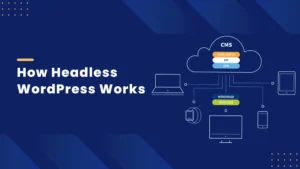
Headless WordPress: A Complete, No-BS Guide to Benefits, Setup, and SEO (with Code)
Modern websites need to be fast, secure, easy to edit, and flexible enough to publish content to more than just a website (think mobile apps, kiosks, and even smart devices). Headless WordPress gives you exactly that: the editorial experience you love in WordPress, plus the performance and developer freedom of modern frontend frameworks like Next.js or Nuxt.
In this guide, you’ll learn what headless WordPress is, when to use it, the exact steps to set it up, how to handle SEO the right way, and how to avoid common pitfalls—with copy-paste code to get you going quickly.
Table of Contents
- What is Headless WordPress?
- Who Should (and Shouldn’t) Go Headless
- Key Benefits
- Trade-Offs & Risks
- How Headless Architecture Works
- Step-by-Step Setup
- SEO in Headless WordPress (What Actually Matters)
- Performance Checklist
- Security & Maintenance
- Common Mistakes to Avoid
- FAQs
- Wrap-Up & Next Steps
What is Headless WordPress?
Headless WordPress means WordPress is your content brain (CMS) and exposes content via an API (REST or GraphQL). Your frontend—the “head”—is a separate app (e.g., Next.js, Nuxt, SvelteKit, Gatsby, Remix) that consumes this API to render pages. Editors still log into WordPress as usual; developers build the site with modern tooling; visitors get blazing-fast pages.
Traditional WP = PHP themes render HTML.
Headless WP = WordPress provides data, a modern app renders HTML.
Who Should (and Shouldn’t) Go Headless
Great fit if you:
- Need speed and Core Web Vitals improvements at scale.
- Want a modern dev stack (React/Vue, TypeScript, component libraries).
- Publish to multiple channels (web, mobile, screens).
- Have complex front-end interactivity or a design system.
- Care about global scale and CDN-level caching.
Consider staying traditional if you:
- Have a small site or blog with limited dev resources.
- Rely on lots of front-end WP plugins (sliders, page builders, shortcodes).
- Don’t need a custom app framework and are happy with a theme.
Key Benefits
- Performance & UX
Static/SSR pages via frameworks + global CDNs = faster loads and better SEO signals. - Developer Freedom
Choose React/Vue/Svelte, TypeScript, and your own build pipeline. - Omnichannel Content
Push the same WP content to apps, microsites, or devices using the API. - Security
Your public site can be static or serverless with fewer attack surfaces. - Scalability
Cache at the edge; revalidate pages on demand; handle traffic spikes easily. - Editor Happiness
WordPress stays WordPress—Gutenberg, roles, drafts, scheduling, and media library.
Trade-Offs & Risks
- Complexity & Cost: Two codebases (WP + frontend) and devops are more advanced.
- Plugin Limitations: Front-end plugins (sliders, shortcodes) don’t “just work.”
- Preview & Drafts: You must implement live preview and draft rendering.
- SEO Footguns: SEO is great in headless—but only if you handle meta, sitemaps, and canonical URLs correctly.
- Auth & Search: Things like protected content and site search require custom endpoints or 3rd-party services.
How Headless Architecture Works
- CMS: WordPress (classic or block editor) + plugins for GraphQL/REST enhancements.
- API:
- REST API:
https://yoursite.com/wp-json/wp/v2/posts - GraphQL (via WPGraphQL):
https://yoursite.com/graphql
- REST API:
- Frontend: Next.js/Nuxt/Gatsby/Remix rendering pages using SSG, SSR, or ISR/On-Demand ISR.
- Delivery: CDN (Vercel, Netlify, Cloudflare) for edge caching and image optimization.
- Revalidation: Webhooks so publishing in WP triggers republish of changed pages.
Step-by-Step Setup
A. Prepare WordPress
- Permalinks: Settings → Permalinks → Post name.
- Install core plugins:
- WPGraphQL (GraphQL API)
- WPGraphQL for ACF (if using ACF fields)
- Advanced Custom Fields (model custom fields)
- Headless Mode (optional: disable theme rendering)
- Application Passwords or JWT Auth (secure API access)
- Yoast SEO or Rank Math (for editorial SEO fields)
- Redirection (manage 301/410 at the CMS level)
- WP Sitemap (Yoast/Rank Math can generate XML sitemaps)
- Security basics:
- Restrict
/wp-adminand/xmlrpc.phpaccess. - Enforce HTTPS.
- Add WAF (Cloudflare/host).
- Restrict
B. Model Your Content
- Use Custom Post Types (e.g.,
case_study,docs) and Taxonomies (e.g.,topic,industry). - Add ACF fields (hero, SEO, Open Graph fields, schema data).
- Plan slugs and URL patterns (e.g.,
/blog/{slug},/topics/{taxonomy}).
C. Choose a Frontend
- React: Next.js (best-in-class for SSG/SSR/ISR)
- Vue: Nuxt
- Svelte: SvelteKit
- Others: Gatsby, Remix
If you want the simplest production path, start with Next.js + WPGraphQL on Vercel.
D. Fetch Content (GraphQL & REST)
GraphQL example (Next.js getStaticProps):
// pages/blog/[slug].js
export async function getStaticPaths() {
const res = await fetch(process.env.WP_GRAPHQL_ENDPOINT, {
method: 'POST',
headers: {'Content-Type':'application/json'},
body: JSON.stringify({
query: `
{ posts(first: 100) { nodes { slug } } }
`
})
});
const { data } = await res.json();
const paths = data.posts.nodes.map(p => ({ params: { slug: p.slug } }));
return { paths, fallback: 'blocking' };
}
export async function getStaticProps({ params, preview, previewData }) {
const isPreview = Boolean(preview);
const query = `
query PostBySlug($slug: ID!, $idType: PostIdType!) {
post(id: $slug, idType: $idType) {
title
content
date
excerpt
seo { metaDesc title opengraphTitle opengraphDescription }
featuredImage { node { sourceUrl altText } }
slug
}
}
`;
const variables = { slug: params.slug, idType: isPreview ? "DATABASE_ID" : "SLUG" };
const res = await fetch(process.env.WP_GRAPHQL_ENDPOINT, {
method: 'POST',
headers: {'Content-Type':'application/json'},
body: JSON.stringify({ query, variables })
});
const { data } = await res.json();
if (!data?.post) return { notFound: true };
return {
props: { post: data.post },
revalidate: 60 // ISR: revalidate every 60s
};
}
REST example (fetch latest posts):
const posts = await fetch(
`${process.env.WP_REST_URL}/wp-json/wp/v2/posts?per_page=10&_embed`
).then(r => r.json());
E. Routing, Images, and Preview
- Routing: Map WP slugs to frontend routes (
/blog/[slug]). - Images: Store in WP; serve through the frontend’s optimizer (e.g.,
next/imagewith absolute WP URLs) or an image CDN. - Preview:
- Install WPGraphQL Preview.
- Set a Preview Secret in WordPress; implement
/api/previewin Next.js to load drafts securely. - Make sure drafts and scheduled posts render correctly for editors.
Next.js Preview route example:
// pages/api/preview.js
export default async function handler(req, res) {
const { secret, slug } = req.query;
if (secret !== process.env.PREVIEW_SECRET || !slug) return res.status(401).end();
res.setPreviewData({});
res.writeHead(307, { Location: `/blog/${slug}` });
res.end();
}
F. Deploy & Cache
- Deploy the frontend to Vercel/Netlify/Cloudflare.
- Use ISR/On-Demand Revalidation: trigger rebuilds when posts publish/update.
- Cache GraphQL/REST at the edge (Vercel Edge, Netlify Edge, Cloudflare) with short TTLs + SWR patterns.
SEO in Headless WordPress (What Actually Matters)
- Server-rendered HTML
Use SSG/SSR/ISR so bots see full HTML (titles, meta, structured data) at first request. - Canonical URLs
Always emit<link rel="canonical" href="https://yourdomain.com/blog/slug">. - Meta Title & Description
Pull from Yoast/Rank Math fields via GraphQL and render in<head>. - Open Graph & Twitter
Set OG/Twitter meta for rich sharing; include a default fallback image. - Sitemaps
Keep using WordPress XML sitemaps and register them in Search Console. Optionally proxy them via the frontend if you need vanity paths. - Schema Markup (JSON-LD)
AddArticle,BlogPosting,BreadcrumbList,FAQPagewhere relevant. - Pagination & Archives
Use proper rel links & unique titles/descriptions per paginated page. - Performance
Optimize LCP, CLS, INP. Lazy-load below-the-fold, compress images, prefetch routes. - Redirects
Manage legacy URLs with 301s from WordPress or at the CDN edge. - Internationalization (if needed)
Usehreflangand locale-aware sitemaps.
Performance Checklist
- ✅ SSG/ISR for all marketing pages and blog posts
- ✅ Critical CSS, image optimization, font-display: swap
- ✅ Cache GraphQL responses; avoid N+1 queries
- ✅ Use responsive image sizes and AVIF/WebP
- ✅ Defer non-critical scripts; remove unused JS/CSS
- ✅ Edge caching with cache-tags for instant purge on publish
Security & Maintenance
- Harden WordPress (WAF, updates, backups, least-privilege).
- Restrict API auth; use App Passwords or JWT for protected routes.
- Keep WP and plugins updated; monitor with automated scans.
- Separate concerns: content on WP hosting; frontend on serverless/CDN.
Common Mistakes to Avoid
- ❌ Building a JavaScript-only SPA with no SSR—bots see empty shells.
- ❌ Ignoring preview/draft flows—editors need parity with classic WP.
- ❌ Treating Yoast/Rank Math as “automatic”—you still must render meta on the frontend.
- ❌ Forgetting redirects and canonicals after a migration.
- ❌ Letting image sizes balloon—optimize and set width/height to avoid CLS.
FAQs
Is headless WordPress good for SEO?
Yes—if you use SSG/SSR/ISR, render meta, configure canonicals, and keep sitemaps intact. Many headless sites outperform classic WP on Core Web Vitals.
Can I still use Gutenberg or ACF?
Absolutely. Editors keep Gutenberg/ACF; developers render those fields in the frontend.
Do my plugins still work?
Back-end plugins (security, editorial, SEO fields) work fine. Front-end plugins that inject markup into PHP themes won’t.
How do I do search?
Use a service like Algolia or Elastic; index content from the WP API.
What about eCommerce?
Use WooCommerce APIs or consider a commerce backend (e.g., Shopify, BigCommerce) with WordPress for content.
Wrap-Up & Next Steps
Headless WordPress blends editor comfort with developer power and elite performance. If you’re scaling content, chasing perfect vitals, or building across channels, it’s a strong choice.
- Prototype with Next.js + WPGraphQL.
- Implement proper preview, SEO meta, and ISR.
- Measure Core Web Vitals and iterate.
